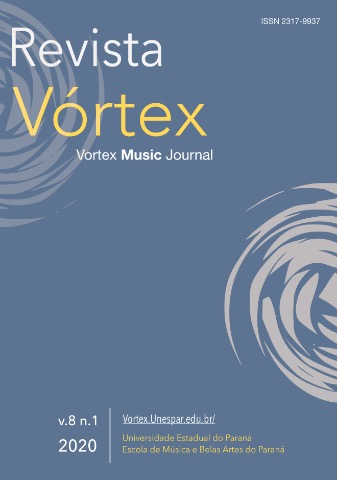Teaching electronic music – journeys through a changing landscape
DOI:
https://doi.org/10.33871/23179937.2020.8.1.12Resumen
In this essay, electronic music composer Simon Emmerson examines the development of electronic music in the UK through his own experience as composer and teacher. Based on his lifetime experiences, Emmerson talks about the changing landscape of teaching electronic music composition: "˜learning by doing' as a fundamental approach for a composer to find their own expressive voice; the importance of past technologies, such as analogue equipment and synthesizers; the current tendencies of what he calls the "˜age of the home studio'; the awareness of sonic perception, as opposed to the danger of visual distraction; questions of terminology in electronic music and the shift to the digital domain in studios; among other things. [note by editor].
Descargas
Citas
EMMERSON, Simon. (1989), 'Composing Strategies and Pedagogy', Contemporary Music Review 3(1), pp. 133-144
______. (1991), 'Live Electronic Music in Britain: three case studies', Contemporary Music Review 6(1), pp. 179-195
______. (1994), "˜"˜Live"™ versus "˜real-time"™"™, Contemporary Music Review 10(2), pp. 95-101
______. (2001), "˜New spaces/new places: a Sound House for the performance of electroacoustic music
and sonic art"™, Organised Sound 6(2), pp.103-105
______. (2007), Living Electronic Music, Aldershot: Ashgate (now Routledge).
______. (2009), "˜Personal, local, universal – where are we?"™, Proceedings of the Electroacoustic Music Studies Network Conference 2009 (EMS09), Buenos Aires. http://www.ems- network.org/ems09/papers/emmerson.pdf
______. (2013), "˜Rebalancing the discussion on interactivity"™, Proceedings of the Electroacoustic Music Studies Network Conference 2013 (EMS13), Lisbon. http://www.ems-network.org/spip.php?article384
______. (2017), "˜Performance with Technology: Extending the Instrument – From Prosthetic to Aesthetic"™, in The Routledge Companion to Sounding Art (Marcel Cobussen, Vincent Meelberg and Barry Truax eds.), New York: Routledge, pp.427-437.
______. (2018), The Routledge Research Companion to Electronic Music: Reaching out with Technology (editor and contributor), Abingdon: Routledge
Descargas
Publicado
Cómo citar
Número
Sección
Licencia
Derechos de autor 2021 Vortex Music Journal

Esta obra está bajo una licencia internacional Creative Commons Atribución 4.0.
Los autores conservan los derechos de autor y conceden a la revista el derecho de primera publicación, con el trabajo simultáneamente bajo la licencia Creative Commons Attribution Licence que permite compartir el trabajo con reconocimiento de autoría y publicación inicial en esta revista.






